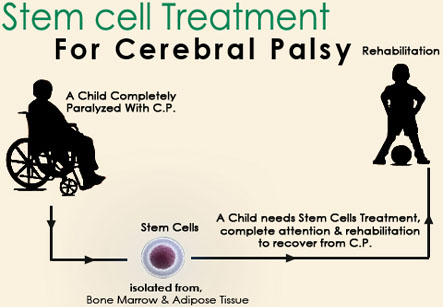Cerebral Palsy
Introduction
Cerebral Palsy is a generalized nerve disorder that can be crippling and severely debilitating. It occurs in babies and children usually caused by damage to the brain during pregnancy, delivery or shortly after birth. Most children with cerebral palsy may suffer from epilepsy or seizures, loss of hearing and sight, difficulty in speech, loss or lack of co-ordination and moderate to severe mental retardation. It is suggested that apart from injury some cases of cerebral palsy are caused due to anemia and malnutrition in the mother during pregnancy, exposure to certain viruses or X rays and lack of oxygen. A very premature delivery also places a baby at risk of cerebral palsy.
Iranian scientists have moved to the forefront in embryonic stem cell research, according to a recent joint study by Harvard University and the Massachusetts Institute of Technology

Role of stem cells
Since there may be damage to the brain cells due to infections, injury or lack of oxygen, stem cells may be of use. Stem cells are primitive cells in the body that have the capacity to become any cell. In these patients they are coaxed to become and replace the damaged nerve cells of the brain. Stem cells and bone marrow cells have been used since 1968 in patients with blood cancers like leukemia, aplastic anemia, lymphomas such as Hodgkin’s disease, multiple myeloma and even in ovarian and breast cancers.
…cells can help in development of new blood vessels in the brain…
Many of these stem cells can come from the cord blood or the blood in the umbilical cord that joins the baby to the mother in the womb. After birth the cord blood can be collected and processed to make stem cells that are then given to the baby with cerebral palsy. These cells can help in development of new blood vessels in the brain, increase the number of new nerve cells in the brain, stimulate brain growth, make the muscles stronger and improve immunity of the child.
Evidence of benefits
In some clinical trials where stem cells have been used there has been significant improvement in the children in the first few months. The initial improvement is usually seen in improvement of the tone of the muscles that is followed by an increased vocabulary, socialization and improved comprehension. Most experts believe that cerebral palsy may also have roots in exposure to heavy metals or poisoning. These include lead or copper. Thus these children also need to be treated for such poisonings and exposure to these chemicals must be prevented and they may need continued speech and vocational therapies for further development. Stem cell therapy may be a step toward therapy in children with cerebral palsy – a condition that is largely considered incurable.